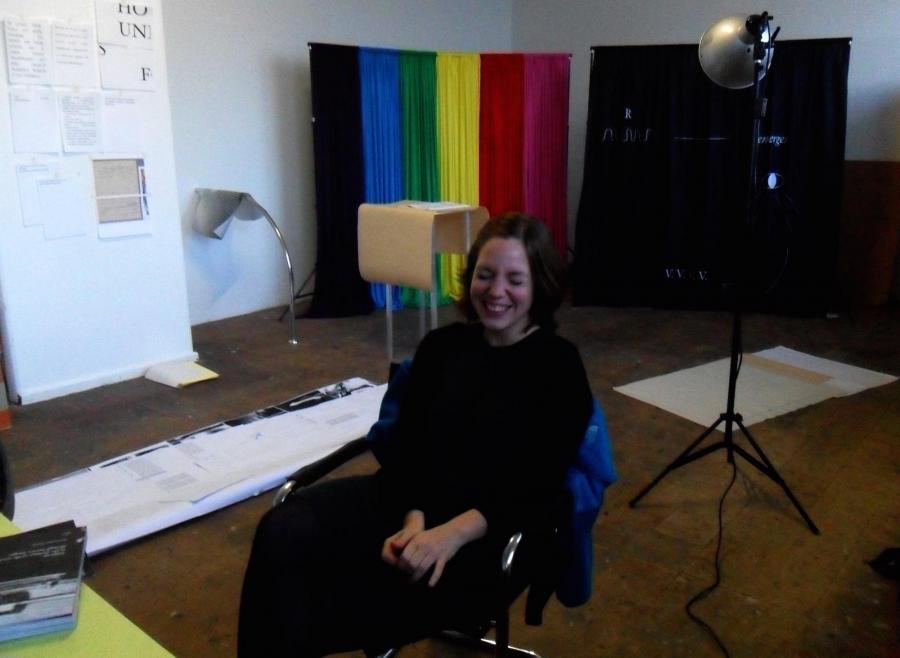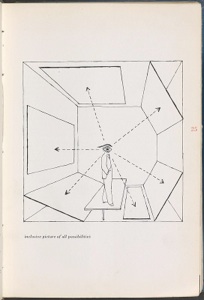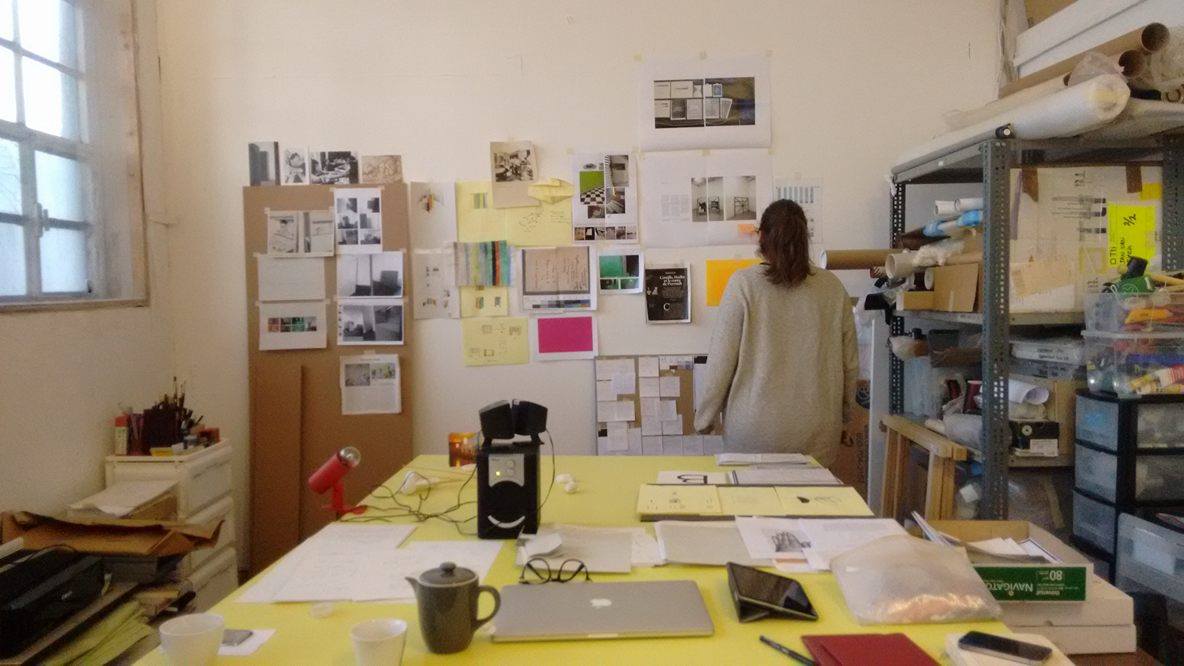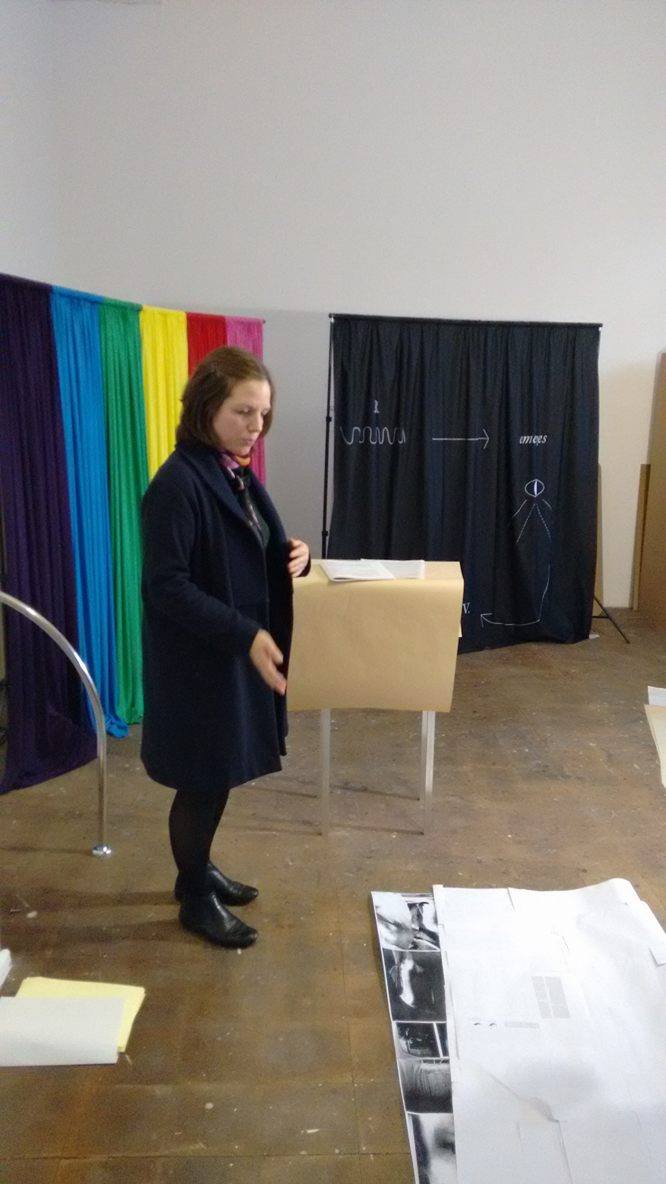Have you met... Dominique Hurth
Have you met... Dominique Hurth

First round: Dominique Hurth, a French artist based in Berlin who wanders from printed matter to installation and sculpture. She focuses on a research approach and on the speaking to the collective real as a subjective practice. We were welcomed in her studio located in the Kunstfabrik Am Flutgraben and talked about art books and self-publishing, among many other things. You make a large use of many medium and languages, from video to installation, from sculpture to book. How would you describe your research?
My work revolves mostly around installation practice and it has always got to do with an object, a series of objects and printed matter. A lot of works are sculptures or installation, and they also often involve new editions or printed moment.

 Dominique Hurth, drawing (inclusive picture of all possibilities)
Dominique Hurth, drawing (inclusive picture of all possibilities)One of your work is called “drawing (inclusive picture of all possibilities)”. The starting point of this work is the reading of “Fundamentals of Exhibition Design” (1937), a book by Herbert Bayer. How do you stand and interact with other authors' work?
This work is quite old and a lot of things have changed since then. A that time, I was really interested in reconstructing things.My main goal through this reconstruction of objects was to try and answer questions which I could not answer. Research has always played a big role in that it is also looking at one person’s work through archives. And I find archives very inspiring. Bayer worked as an exhibition designer. He, as well as many others, are figures that have been appearing in my work. What is interesting for me is what is often misread, even if there is no information at all or if there is information not giving us the whole story, making it difficult to find the proper information level. I guess this is the starting point of my work. In which direction is your work moving now?
I used to focus on the question of reproducibility and authenticity. I could have spent my whole life exercising this practice, but it would have quickly become boring for me. Writing became more important and both research in the archives and in the studio became more important. It became less about the object and more about all the things around. Moments of public reading started to become more important. As far as sculpture is concerned, I still believe that an object has a voice and speaks for itself, but I am also interested in having a new voice in the backdrop. The audience obviously also pays a big part in a public reading. I think this aspect of writing (and reading) became more important, and my work now is really much about me spending a lot of time researching.
 How do you relate with images and writing in your works and how is one language related to the other?
I would say that it is not only about “image” and “word” but also about “materials”. A language that can materialize through a visual, a material, or a text. Most of the things happen in the studio. For me sculpture is very similar to writing, it is a pen on paper. They share the same process: it is about syntax, semantic and trying to find a subject. “Images” also implies a question of how to read them and what is contained in them. For me writing is also “images”, writing means building sentences and figuring out how you can have punctuation marks on images… Could an image be a punctuation mark? I am definitely not a writer, I use texts as I use a sculpture object, and an image of course speaks too. A text can say a lot or can say nothing depending on if it is read aloud or is been read not aloud, it is a very material thing.
How do you relate with images and writing in your works and how is one language related to the other?
I would say that it is not only about “image” and “word” but also about “materials”. A language that can materialize through a visual, a material, or a text. Most of the things happen in the studio. For me sculpture is very similar to writing, it is a pen on paper. They share the same process: it is about syntax, semantic and trying to find a subject. “Images” also implies a question of how to read them and what is contained in them. For me writing is also “images”, writing means building sentences and figuring out how you can have punctuation marks on images… Could an image be a punctuation mark? I am definitely not a writer, I use texts as I use a sculpture object, and an image of course speaks too. A text can say a lot or can say nothing depending on if it is read aloud or is been read not aloud, it is a very material thing.

A book has an own life that keeps existing in the reader's hands. What interaction does an art book create between the artist and the public?
What I am interested in is the very subjective view of the archives. I do not especially adopt a scientific approach, and it is also about inquiring at how accessible the archives material is (or isn't). It is not coming from a historical desire of showing things that have never been shown, and creating connections between different things that do not necessary happen from a historical investigation but much from a subjective artistic approach. It is about images and how one can read images and I wish at least that the reader also has my own way of reading images. Even if there is a caption of images I chose and I give him/her my view on them, there is still a gap between me and the reader that I am interested in because it can vary a lot depending on who you are. I find the intimacy of a book quite interesting, and very different to find with an installation, there you read differently and look at differently. The materiality is very important… it is a very tactile moment, between you and the object.
Could you tell us about the “The reading room” project?
Th Reading room was meant to give a space for artists' publications. It doesn’t exist anymore, but it was run by me and the artist Ciarán Walsh for two years and a half and took place in different places like Berlin, Paris, Birmingham or Barcelona. It originally started as a space with a collection of artists' books in an apartment that people could visit by appointment only. Some artists' books are real objects and necessitate proper care, but you don’t know how to look at them in bookshops. You need also time to select a hundred of books or printed matters and to make them accessible. The room hosted a series of readings, public presentations and audio works. The idea was to emphasize the intimacy that occurs between someone spending time in a reading room. It was very simple, it was about intimacy, time and hospitality.
 What about production spaces? Are there spaces and initiatives that connect authors helping them in production and creative processes?
I think that production places do exist and are initiated by artists and designers. I have been involved in many projects looking at artist books and distribution, not in terms of selling but in terms of intimacy and relations between the reader and the book. Those spaces are rarely bookshops or galleries, they exist because there is a need of exchanging. What I witnessed during the past five years is that there are a lot of connected works of printed matter, we exchange a lot.
What about production spaces? Are there spaces and initiatives that connect authors helping them in production and creative processes?
I think that production places do exist and are initiated by artists and designers. I have been involved in many projects looking at artist books and distribution, not in terms of selling but in terms of intimacy and relations between the reader and the book. Those spaces are rarely bookshops or galleries, they exist because there is a need of exchanging. What I witnessed during the past five years is that there are a lot of connected works of printed matter, we exchange a lot.I think there are always conflicts between practices and public settings. Things may happen in network settings. I do things that are at least for the people I work with, full of strong connections, but it happens because perhaps someone got money and at some point could invite other people and so on… What you bring out is a constant conflict as well, because when we talk about artist books we are not talking about printing five hundreds copies. What I find interesting is that there are people actively collecting. There is a couple of collectors who also share their collections in public in moments and public viewings. Even if it is under closed walls, physical space is perhaps more relevant, like a library actually. For instance the Centre Pompidou in Paris collects a lot of artists' books. Could you tell us about the work you are producing for Friends with Books? Two things will happen, one object and one performance.I am showing a work that took me three years in the making and shown last year in New York which involves the reconstruction of an object and archival research. One part of that looks at the first women who did photography publicly known and who were publishers and really used publishing as a practice. Then, the other part of the work is included in the public program “Séance de lecture” which has been going on for a couple of years. This is a public and performative reading of different materials since it has been developing in different ways, involving different people as well, and it has been looking at specific legacies of Stéphane Mallarmé and a book that could exist only in a public moment as a gradient of collective moments. The two projects are not connected per se, but they are linked in terms of space and they developed in the same time-frame. They reflect around a timeframe around the 1860’s, when technology and photography, as well as the book making started to operate. “Séance de lecture” is looking at what can the printed matter add in a collective real rather than in a private moment.
 Dominique Hurth, Séance de lecture
Dominique Hurth, Séance de lecture
What do you think is the future of the art book and what is the state of self-publishing today?
I think the art book is alive and kicking. I find that quite interesting that a lot of art books are coming in the e-book format because I come from a very material-based practice. First of all if you wait for funds to make something you are going to make nothing. Self-publishing really comes from this economy of layers and also from practical things like looking at how much money do you spare, how can you work, who do you want to work with, what can you exchange, what can you print for free, what can you eventually print again on something else. It really comes from a practice. It is very positive to think about it in that way, and not just at something founded. There is a lot of freedom as well.
I work with a distributor based in Barcelona, she is called Anna Pahissa and she runs múltiplos. I met her when I was in Barcelona, I gave readings of books at her place. We have a strong dialogue and a really productive relationship. It comes from a friendship but also a trust and that, for me, is amazing. She is really doing a great work. And...she pays the artists. This is not the topic, but it actually remains a big problem because no one ever talks about it. Distribution means often that you can wait for your work or your book to be paid for years, we don’t make any profit anyway. What is also very exciting is that you also don’t know where your book is going. I find quite beautiful when you get an email from someone who got one of your book.
What are you reading at the moment? I am reading the Kolyma Tales by Varlam Shalamov in French. It is a collection of short stories about a man who spent 30 years in the gulags. Quite grim but very beautiful at the same time. My mother gave it to me when I was ten and I had still not read. You can find Dominique's work at the exhibition of Friends with Books, 11-13 December, Hamburger Bahnhof. She will also host a Séance de Lecture on Saturday 12.11.2015 at 17.00h at the fair.